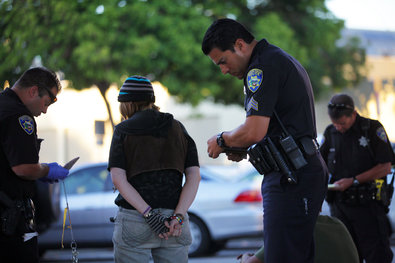
Can Predictive Policing Be Ethical and Effective?
More police departments are trying to predict crime through computer analysis of data, part of the growing trend of using algorithms to analyze human behavior. Advocates say this approach focuses on those most likely to commit crimes, allowing for better relationships between police and residents. But critics say the computer models perpetuate racial profiling and infringe on civil liberties with little accountability, especially when the forecasting models are built by companies that keep their methods secret. Does predictive policing work? Can it decrease crime without infringing on civil liberties?
* predict = 예측[예견]하다/ computer analysis = 컴퓨터 분석/ algorithm = (특히 컴퓨터) 알고리즘/ human behavior = 인간행동/ advocate = 지지자, 옹호자/ commit a crime = 죄를 짓다/ resident = 거주자[주민]/ perpetuate = 영구화하다, 영속시키다/ racial profiling = 인종 프로파일링(피부색, 인종 등을 기반으로 용의자를 추적하는 수사 기법)/ infringe on ~ = ~을 침해하다/ civil liberties = 시민(적) 자유/ accountability = 책임, 의무/ policing = (경찰의) 치안 유지 활동
 예측에 따른 치안 유지 활동이 효과가 있나요? 시민의 자유를 침해하지 않고 범죄를 줄일 수 있나요?
예측에 따른 치안 유지 활동이 효과가 있나요? 시민의 자유를 침해하지 않고 범죄를 줄일 수 있나요?
1. Be Cautious About Data-Driven Policing
Technology that purports to zero in on an individual who is likely to commit a crime is particularly suspect.
2. Use of Data Can Stop Crime by Helping Potential Victims
Saving lives and reducing gun violence require caring about young men and women whom the justice system typically only views as “offenders."
3. Technology Shouldn’t Replace Community Resources
Police should avoid over-reliance on algorithms and make sure residents are a part of any plan to reduce crime.
4. Social Media Will Help Predict Crime
Predictive technology is still young, but social media, wearable devices and online search can already be used to predict events, including crime.
5. Data Is Not Benign
The model takes data and predicts the need for policing, rather than tools to deal with social trauma that may create criminal behavior.
6. Predictive Algorithms Are Not Inherently Unbiased
Over-reporting of crime incidence by law enforcement in minority communities will literally color the computational analysis, designating these areas a "hot spot" for more policing.
Sample Essay
Be Cautious About Data-Driven Policing
In every age, police forces gain access to new tools that may advance their mission to prevent and combat crime. Predictive technologies — the use of data from a variety of sources to create an assessment model for the probability of future crimes — have been touted as a means to forecast where crime will likely take place and sometimes who is likely to commit a crime.
Given the far-reaching implications of acting on such projections, any police department considering a predictive analytical tool must thoroughly test the reliability of its claims. So far, research is in its infancy.
A handful of studies have shown short-term decreases in crime when police allocate resources to predicted “hotspots,” but other assessments have showed no statistically significant correlation or diminishing returns.
At a time of rising concern about over-policing in minority communities, surging police to particular locations may have its own compounding negative consequences. Technology that purports to zero in on categories of people likely to commit crimes is even more suspect. It undermines the constitutional requirement that police should target people based upon an individual suspicion of wrongdoing, not statistical probability.
Of course, even algorithms used to predict the location of crime will only be as good as the information that is fed into them. If an algorithm is populated primarily with crimes committed by black people, it will spit out results that send police to black neighborhoods. This is a serious and perhaps insurmountable problem, considering that people of color are stopped, detained, arrested and incarcerated at higher levels than whites regardless of crime rates. The New York Police Department’s infamous stop-and-frisk program overwhelmingly targeted black and Latino men, even though the number of arrests or summons resulting from stops was actually lower for minority targets. The risks of “driving while black” are also well-documented.
These realities mean we, as a society, should proceed with extreme caution despite the hype about the promise of data. Predictive policing shouldn’t just become racial profiling by another name.





![]() 예측에 따른 치안 유지 활동이 효과가 있나요? 시민의 자유를 침해하지 않고 범죄를 줄일 수 있나요?
예측에 따른 치안 유지 활동이 효과가 있나요? 시민의 자유를 침해하지 않고 범죄를 줄일 수 있나요? 






